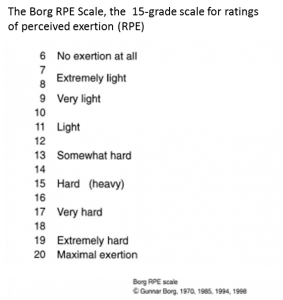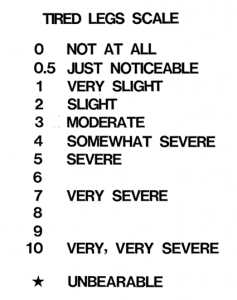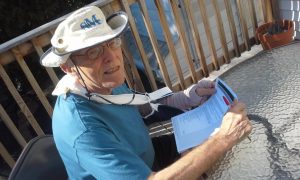Leg fatigue is a key symptom encountered during distance running. And last spring, short hikes used to really tire me out! Overall tiredness and wobbly legs were part of my fatigue when walking or running. How come?
Increasing leg fatigue during exercise indicates that the leg muscles are acquiring task failure. Deconditioning results in more leg fatigue at a given pace. And fatigue occurring for a long time after intense exercise is common for persons with myalgic encephalomyelitis as well as chronic fatigue syndrome (ME/CFS) and with multiple sclerosis (MS). Thus, leg fatigue is an important symptom pointing to some of the limiting factors of distance performance.
How did this leg fatigue happen?
Phil Weiser[i] (P): This is the first Endurance-Education Blog Post I’ve written since April 2015. And I am joined in this and future posts by my brother, Karl Weiser.
Karl Weiser[ii] (K): I’ve enjoyed proofing your drafts and thanks for the invitation to be an associate editor! Say you had quite a stumble and fall about the time we worked on the last post. What happened?
P: Shortly after I published my last blog post, in March 2015, I experienced quite an extensive left elbow injury.
- Anne, my wife, and I were hiking in a nearby park here in Philadelphia with the wind whistling past my hearing aids.
- I listened to the whistling for a moment and went running to catch up with Anne on a stretch of beautiful trail next to Wissahickon Creek.
- Running, then, was easy; my running effort was “light” (a Rating of Perceived Effort of 11)
 and my Rating of Leg Tiredness was “no at all” (a rating of zero).
and my Rating of Leg Tiredness was “no at all” (a rating of zero).

- Suddenly, I tripped on a root and started to recover by doing a forward somersault.
- But I stubbed my toe again on a second root, and I was sent tumbling onto my face.
- Quickly I put out my left arm out as a brake and BOOM! I drove my left upper arm bone several inches down in-between the two lower arm bones.
- Also a little pop occurred, as my left funny bone was jerked off the upper bone.
P: There I was, lying partly on my right side, yet mostly face down, falling half off the trail.
- Anne hurried back down the trail, concerned how I was doing.
- And I told her, “I am stunned, in shock, but not in much pain, only in lots of discomfort.”
- Fortunately another person came by, and Anne asked her to go up a nearby horse trail to the stables above us and call 911 and the Wissahickon Park Rangers.
- I did another mental body scan (“nothing smarts!”) and touched my left elbow to notice a bone (the radius) that was sticking up under my skin.
- And I could feel no broken skin or blood (therefore, a closed dislocation/fracture). I gave out a big sigh of relief!
After you fell, then what occurred?
K: Wow. I had no inkling that all this happened to you. Then what happened?
P: Two Park Rangers just happened to be at the stables.
- They maneuvered their SUV backing down the horse trail and part way up the hiking trail to within about 100 meters of us.
- they wrapped a triangular bandage around my elbow and body.
- After more talking with the Philly Fire Department EMTs, they enlisted two others to do a four person carry to lift me up.
- “EH-OUU,” I cried out in pain. I was no longer in a little discomfort.
- Once they settled into to the carry, they walked very slowly to the SUV, and they transferred me gently into the back seat behind the driver. They even put a seat belt carefully around me.
- At last, one of them drove the SUV slowly up the trail to meet the EMTs up at the stable.
K: Hey. We did many practice four person carries in the Boy Scouts and when you were doing Timberline Search & Rescue. Then what happened?
P: There the EMTs helped me out of the Park Rangers’ SUV, of course, but there was a backboard sitting on the ground that I was placed upon and strapped down snugly. “All the better to keep your elbow together,” one of them said!
- The other turned on the siren, and off we went.
- “Very strange,” I thought, “I am now not outside an ambulance, but inside, and listening to the siren as we went buzzing along the streets to a hospital.”
Now came the time to slowly recover and feel less fatigue
K: What an experience! How was your recovery?
P: For me, recovery from this injury was not an ordinary experience:
- Later on the same day as my fall, orthopedic surgeons told me that they had anesthetized me and did some jerks on my left wrist to realign my arms; the x-rays images assured them that my elbow joint would be functioning ‘normally.’
- Two weeks later, they used two screws to refasten my funny bone to the upper arm bone, reapplied the cast, and sent me home.
- Now I ‘had’ to start slowly bending my elbow and rotating my hand.
- Also my physical therapist allowed me to progressively lift heavier and bulkier grocery bags and to increase my walking distance.
K: Did your recovery from that injury change your perceptions of leg fatigue and exertion during exercise?
P: Many months passed until I could run again using a “Light” effort of (RPE of 11) and only a slight Rating 0f Leg Tiredness (RLT of 2).
- Reality showed me that a 73 year old will need much more time and endure more pain during my recovery than just watch the elbow skin heal and get the physical therapy range of motion exercises done.
- First came the physical healing but at the same time my body became deconditioned. In fact I was getting more and more tired just walking up stairways or hills.
- Because of the bash I took, it jangled my whole body so much, that my hidden, sleeping Lymn’s Disease bugs woke up and came out of hiding.
- That’s when I began to re-experience the three of the dastardly symptoms for chronic Post-Exertional Malaise (PEM): Fatigue Pain, and Cognitive Dysfunction (feeling Foggy Headed).
- Slowly with plenty of pacing for everyday activities of living, naps and rest periods, and boosts from tea laced with honey and from chocolate I could advance from walking to jogging to running. Exercise was only twice a week; light weight lifting was also once or twice a week to help forestall relapsing.
Dawes et al. (2014) referenced our 1970s research!
K: Did your injury help you further study the science of how perceptions change during exercise?
P: While recovering from the dislocated left elbow, I did read some scientific articles. And I found a 2014 research article that cited one of our early 1970s research articles on fatigue from prolonged bicycle riding[iii], a 1976 chapter and a 1976 symposium paper. Interestingly the study was about leg fatigue in patients with MS done by Dawes et al. (2014)[iv].
K: Please discuss this article in your next post
P: Sure will. Stay tuned.
Endnotes
[i] Phil Weiser (P) is the primary author of the Endurance-Education Blog Posts. I have a PhD in Physiology from the U of Minnesota, with a minor in Biochemistry. My fastest mile is 4 minutes 15 seconds and marathon is 2 hours 29 minutes.
[ii] Karl Weiser (K). He has a MS in Biochemistry from the U of Wisconsin, earned a teaching Certificate at U of Washington, and taught High School Advanced Placement Chemistry. His fastest 3 mile is 13 minutes 47 seconds and marathon is 2 hours and 26 mins.
[iii] Weiser PC, Kinsman RA, Stamper DA. (1973)Task specific symptomatology changes resulting from prolonged submaximal bicycle riding. Med Sci Sports 5:79-85.
[iv] Dawes,H, J Collett, A Meany, J. Duda et.al. (2014) Delayed recovery of leg fatigue symptoms following a maximal exercise session in people with multiple sclerosis. Neurorehabilitation and Neural Repair 28:139-148. DOI:10.1177/1545968313503218.

Enjoyed reading this post for many reasons. One is that I am recovering from a fall myself, last fall, when I got my feet tangled in a stick while birdwatching. I too tucked and rolled to avoid a face plant and fell on my camera. Camera OK, ribs not. Just when recovering enough to hike, kayak and swim, came down with 3 weeks of bronchitis. Now just signed up for Cycle Oregon, the weeklong bike ride in Sept., so I am just beginning the long journey to regain enough fitness to ride 70 miles and 5000 feet elevation gain most days. I think I need a trainer. Am expecting leg fatigue from exertion, will let you know how my perception of fatigue changes with the return of fitness.
Thanks for writing this post Phil and Karl. Phil, we were sailing up in the Sea of Cortez when you injured your arm, and this is the first I heard of the injury, although I did know that the sneaky Lyme Disease had re-occurred. Glad you were able to re-establish your fitness and it’s routines. This gives me hope for my current situation.
Karl, nice to connect with you through writing.
Looking forward to further endurance posts.
Thanks for your comment. We’ve got to watch out for sticks and roots. And you’re on to Cycle Oregon. I sent copy of your comments to Karl. Soon I will switch to comcast email account and continue this note. Love to you and Nikk, Phil